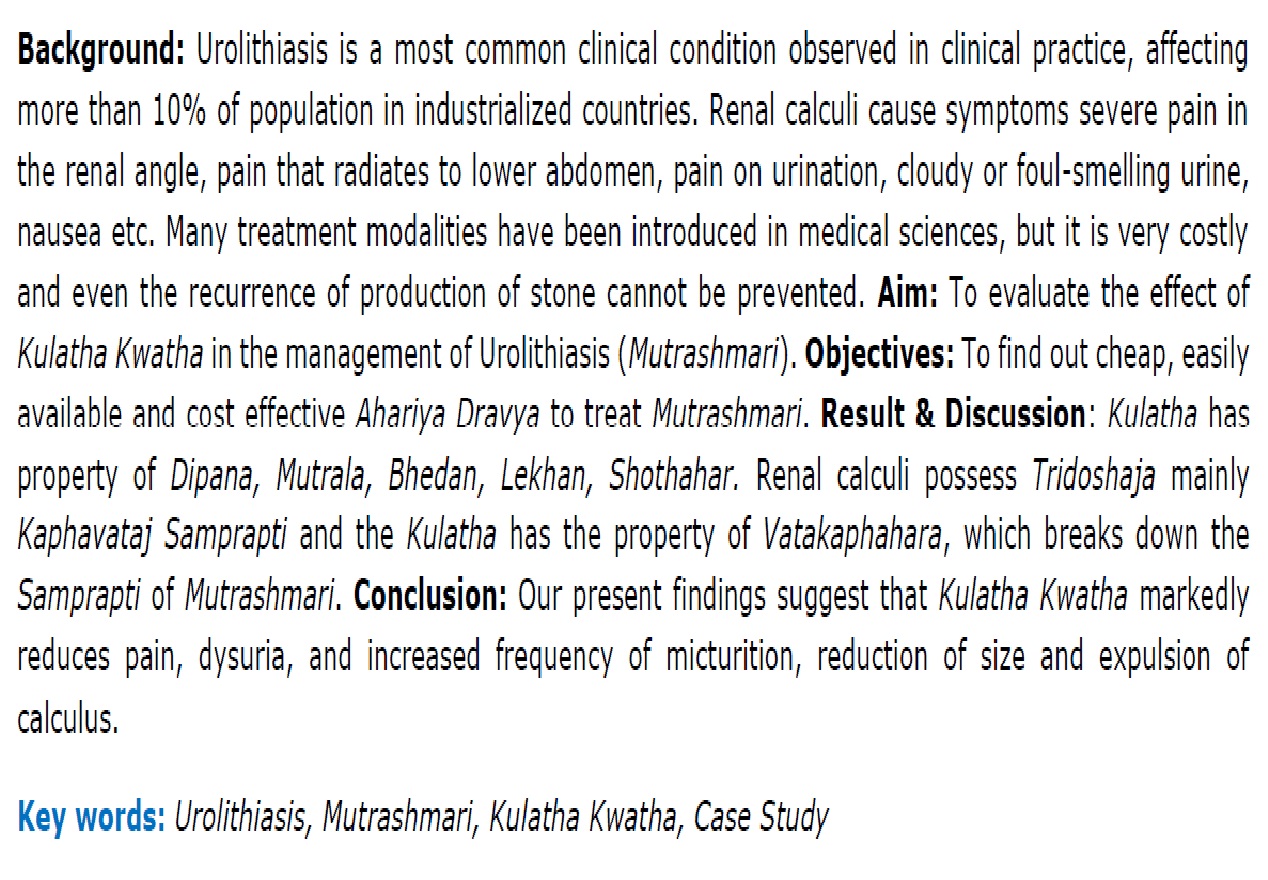Ayurvedic management of Urolithiasis (Mutrashmari) by Kulatha Kwatha - A Case Study
Keywords:
Ayurveda, Urolithiasis, Mutrashmari, Kulatha Kwatha, Case studyAbstract
Background: Urolithiasis is a most common clinical condition observed in clinical practice, affecting more than 10% of population in industrialized countries. Renal calculi cause symptoms severe pain in the renal angle, pain that radiates to lower abdomen, pain on urination, cloudy or foul-smelling urine, nausea etc. Many treatment modalities have been introduced in medical sciences, but it is very costly and even the recurrence of production of stone cannot be prevented. Aim: To evaluate the effect of Kulatha Kwatha in the management of Urolithiasis (Mutrashmari). Objectives: To find out cheap, easily available and cost effective Ahariya Dravya to treat Mutrashmari. Result & Discussion: Kulatha has property of Dipana, Mutrala, Bhedan, Lekhan, Shothahar. Renal calculi possess Tridoshaja mainly Kaphavataj Samprapti and the Kulatha has the property of Vatakaphahara, which breaks down the Samprapti of Mutrashmari. Conclusion: Our present findings suggest that Kulatha Kwatha markedly reduces pain, dysuria, and increased frequency of micturition, reduction of size and expulsion of calculus.
Downloads
References
Asplin JR, Coe FL, Fevus MJ. Disorders of the Kidney and Urinary Tract Nephrolithiasis. In: Fauci AS, Braunwald E, Kasper DL, Hauser SL, Longo DL, Jameson J. et al. editors. Harrison's Principles of Internal Medicine, 17th ed. Vol. II, New Delhi: McGraw-Hill Medical Publishing Division; 2008. p. 1815-7.
Stamolelou KK, Francis ME, Jones CA, Nyberg LM. Curhan GC. Time trends in reported prevalence of kidney stones in the United States. 1976-1994. Kidney Int 2003;63:1817-23.
Lieske JC, Pena de la Vega LS, Slezak JM, Bergstralh EJ, Leibson CL, Ho KL, et al. Renal stone epidemiology in Rochester, Minnesota: An update. Kidney Int 2006;69:760-4.
Colobawalla BN. Incidence of urolithiasis in India ICMR Tech Rep 1971;8:42-51.
Rajgopal Shenoy K, Anitha Shenoy (Nileshwar) Manipal manual of surgery: Kidney and Ureter-Renal stones 2014.935-6.
Evan A. Physiopathology and etiology of stone formation in the kidney and the urinary tract. Pediatr Nephrol 2010; 25:831-841.
Alessandro S, Ferraro PM, Cianchi C, Barsotti M, Gambaro G, Cupisti A. Which Diet for Calcium Stone Patients: A Real-World Approach to Preventive care, Nutrients 2019; 11(5):1182.
Vaidya Yadavji Trikamji acharya, Krishnadas Academy, Varanasi, Commentary Dalhanacharya Nibhandha sangraha and Gayadasacharya Nyaychandrika Panjika on Sushruta Samhita of Sushruta, Chikitsasthana; Ashmari Chikitsa, chapter7; Verse3. Varanasi; Choukhambha sanskrita Samsthana, 7th edition reprinted 1998; p435-441.
Vijayarakshita and Srikantadatta, Madhukosh vyakhya on Madhava Nidana of Madhavakara, Vol-1, Chapter32, Verse1, Varanasi; Choukhambha Sanskrita Samsthana, 20th edition 1993; p514-520.
ICD- 10- CM Codes>N20-N23
Sridevi V, Rajya Lakshmi I, Sanjeeva Rao I. Urolithiasis (Mutrashmari). In: Lakshmi Chandra Mishra (editor). Scientific basis for Ayurvedic Therapies. Boca Raton. CRC pressLLC; 2004, pp 535.
Jeffery LA, Rochelle, Brian S, Arei B. Urology. In Brunicardi F, Charles. Schwartz's (editors). Schwartz's Principles of Surgery, 9th edition. USA. The McGraw-Hill Companies Inc; 2010, pp 1472.















